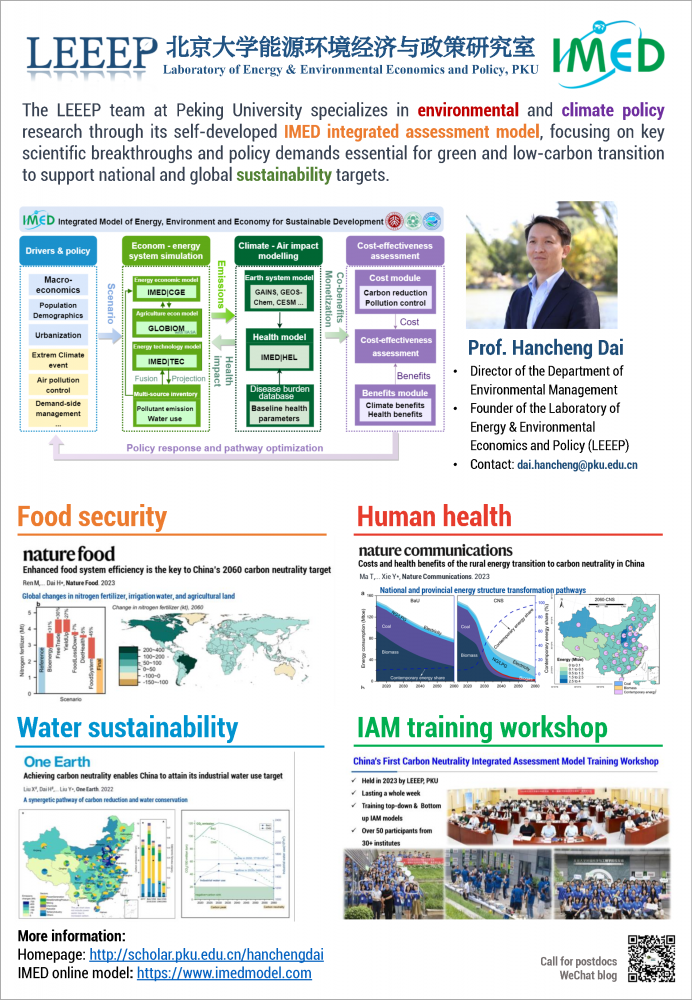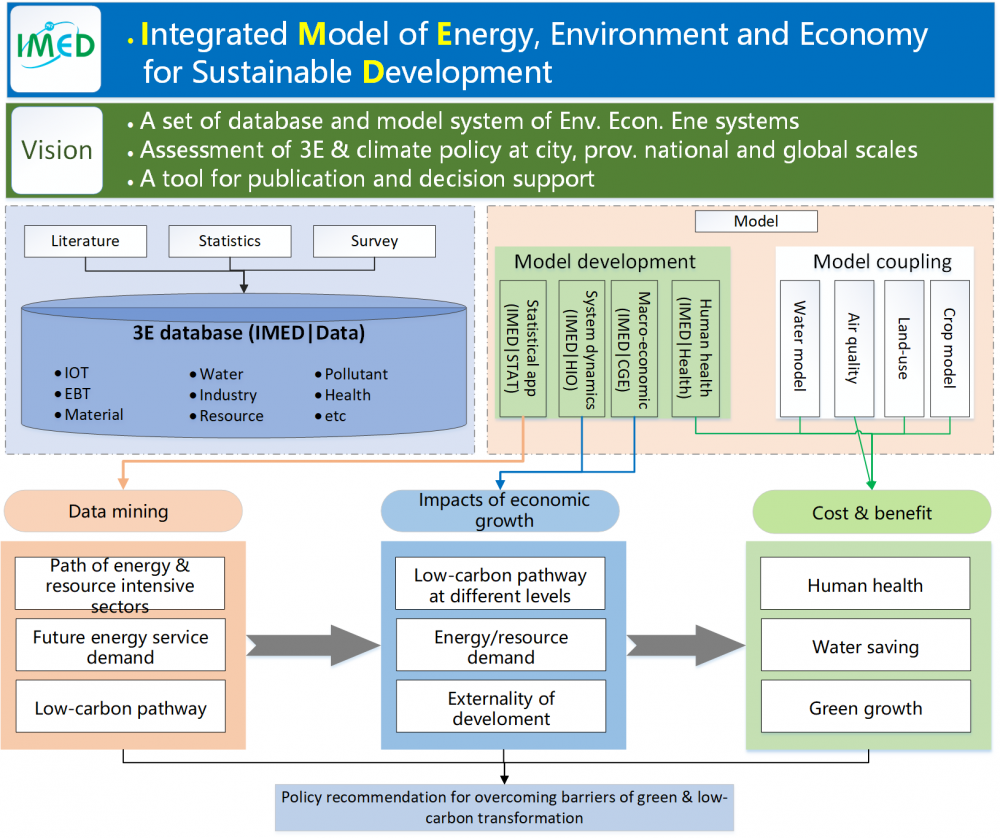Introduction to the Integrated Model of Energy, Environment and Economy for Sustainable Development (IMED) Model could be downloaded here: English Version. A brief review of the peer reviewed papers based on IMED model is available here: Slides of IMED review.
Introduction
Global climate change caused by anthropogenic greenhouse gas (GHG) emissions is one of the major challenges facing mankind this century. As global GHG emissions increase, global temperatures have risen significantly, exceeding the pre-industrial revolution level and resulting in many consequences such as glacier shrinkage, sea level rise, extreme weather and crop yield reduction. The United Nations Framework Convention on Climate Change has called for all countries to take effective measures to reduce their GHG emissions so that the global average temperature rise by the end of this century will not exceed 2-degree from the pre-industrial revolution level, and strive to control it within 1.5 degrees.
China is not only a major emitter of GHGs but also a developing country facing major environmental pressures including air pollution. Since the Reform and Opening-up in 1978, China has made remarkable achievements in economic growth. However, for a long time, the industrial structure is dominated by energy, resource and pollution intensive industries. Meanwhile, its energy structure is dominated by fossil fuels such as coal, leading to overcapacity, environmental degradation, resource depletion, and sharp increase in carbon emissions. Faced with the dual pressures of domestic environmental pollution and international climate mitigation, the Chinese government has made commitment to reduce the intensity of carbon dioxide per unit of GDP by 60% -65% in 2030 as compared with that of 2005 and reach carbon emissions peak by 2030.
The cause and solution of climate change and environmental problems are not only related to pollution discharge but also related to energy, industrial structure, consumption patterns and macro-micro decisions, and have important impacts on health and socio-economic systems (Figure 1). It is a major concern by policymakers and academic communities to seek for appropriate climate mitigation strategy and policy so that it could promote the long-term sustainable socioeconomic development. Hence, development and application of integrated assessment models based on the cognition of various aspects such as energy & industry & development model & pollution control & health protection & social development is not only an academic cutting-edge issue but also meaningful for decision support.

Figure 1: Inter-linkage of Energy • Environment • Economy Systems
The IMED Model at Peking University
In view of the aforementioned pressing background and urgent demand for policy assessment, the Green and Low Carbon Research Group (Homepage: http://scholar.pku.edu.cn/hanchengdai) of College of Environmental Sciences and Engineering at Peking University is devoted to developing integrated assessment model of energy-environment-economy system and contributing to the academic research and policy making of green and low-carbon sustainable development. The model is called IMED, or Integrated Model of Energy, Environment and Economy for Sustainable Development. IMED is a system of databases and models dealing with the complex systems of energy, environment and economy with the purpose of systematically and quantitatively analyzing economic, energy, environmental and climate policies at the city, provincial, national and global scales to provide relevant scientific support for decision making.
In recent years, IMED has been applied systematically to analyze air pollution reduction (Dong et al., 2015), human health (Xie et al., 2016; Xie et al., 2017), resource efficiency (Wang et al., 2018), energy and climate mitigation policies (Dai et al., 2016; Dai et al., 2017,; Dai et al., 2016) of China at the national and provincial levels.

Figure: Overview of LEEEP Research Activity
Key components of the IMED model
As illustrated in (Figure 2), IMED aims to integrate different kinds of models to address various research objectives, including:
- To simulate development pathways of energy, environment and economic systems;
- To explore the mechanisms of driving forces of economic development;
- To investigate the externality of different economic development patterns on resource, energy consumption and environment;
- To quantify the cost and benefit of green and low-carbon transition.
The core concern of IMED model is to focus on the socioeconomic aspects and energy systems, including the following key modules:
- IMED|Data: A data base of energy, environment and economy related to global and national Input-output table, energy balance table, material and resource input output table, industry statistics, environmental pollutant emissions, human health data etc.
- IMED|MIN: Statistical analysis of IMED|DATA using statistical techniques or machine learning techniques to find out laws of how economic development pattern, trajectories of key industry. Ultimately, it could help to obtain a more plausible projection of the future socioeconomic driving forces.
- IMED|CGE: Computable general equilibrium (CGE) models of the global economy and China's provincial and national economy.
- MED|HIO: Hybrid Input-Output model that combines the top-down type input-output analysis and bottom-up type of hundreds of discrete technology choices. The purpose is to account the energy consumption and environmental pollutant emissions under various trajectories of economic development.
- IMED|HEL: IMED|HEL model quantifies the health and economic impacts caused by ambient air pollution. To address the indoor air pollution, we extended the IMED/Health model by introducing an indoor air pollution health impact module.
In addition, by soft-link with other existing models such as air quality model, water resource model, water quality model, crop model, land-use model, climate model etc., IMED model attempts to provide solutions to related policy making from the perspectives of interdisciplinary angle of societal-economic-industrial-energy-environment-climate chains.
IMED Network
IMED aims to be a platform open to the whole academic community, you are
warmly welcome to join the IMED network. Subscribe to our public blog on Wechat
by scanning the following QR code.

Figure 2:IMED Model framework and outlook

Figure 3:Subscribe to our public blog on Wechat
Related papers
- Cheng, Beibei, Hancheng Dai*, Peng Wang, Yang Xie, Li Chen, Daiqing Zhao, and Toshihiko Masui. 2016. “Impacts of Low-Carbon Power Policy on Carbon Mitigation in Guangdong Province, China.” Energy Policy 88: 515–27. http://www.sciencedirect.com/science/article/pii/S0301421515301841.
- Cheng, Beibei, Hancheng Dai*, Peng Wang, Daiqing Zhao, and Toshihiko Masui. 2015. “Impacts of Carbon Trading Scheme on Air Pollutant Emissions in Guangdong Province of China.” Energy for Sustainable Development 27: 174–85. http://www.sciencedirect.com/science/article/pii/S0973082615000563.
- Dai, Hancheng. 2012. “Integrated Assessment of China’s Provincial Low Carbon Economy Development Towards 2030: Jiangxi Province as an Example.” Ph.D. Dissertation, Tokyo Institute of Technology.
- Dai, Hancheng, Toshihiko Masui, Yuzuru Matsuoka, and Shinichiro Fujimori. 2011. “Assessment of China’s Climate Commitment and Non-Fossil Energy Plan Towards 2020 Using Hybrid AIM/CGE Model.” Energy Policy 39 (5). Elsevier: 2875–87. http://www.sciencedirect.com/science/article/pii/S0301421511001558.
- Dai, Hancheng, Toshihiko Masui, Yuzuru Matsuoka, and Shinichiro Fujimori. 2012. “The Impacts of China’s Household Consumption Expenditure Patterns on Energy Demand and Carbon Emissions Towards 2050.” Energy Policy 50: 736–50. http://www.sciencedirect.com/science/article/pii/S0301421512007057.
- Dai, Hancheng, Peggy Mischke, Xuxuan Xie, Yang Xie, and Toshihiko Masui. 2016. “Closing the Gap? Top-down Versus Bottom-up Projections of China’s Regional Energy Use and Co2 Emissions.” Applied Energy 162: 1355–73. http://www.sciencedirect.com/science/article/pii/S0306261915008272.
- Dai, Hancheng, Xuxuan Xie, Yang Xie, Jian Liu, and Toshihiko Masui. 2016. “Green Growth: The Economic Impacts of Large-Scale Renewable Energy Development in China.” Applied Energy 162: 435–49. http://www.sciencedirect.com/science/article/pii/S0306261915012763.
- Dong, Huijuan, Hancheng Dai, Liang Dong, Tsuyoshi Fujita, Yong Geng, Zbigniew Klimont, Tsuyoshi Inoue, Shintaro Bunya, Minoru Fujii, and Toshihiko Masui. 2015. “Pursuing Air Pollutant Co-Benefits of CO2 Mitigation in China: A Provincial Leveled Analysis.” Applied Energy 144. Elsevier: 165–74. http://www.sciencedirect.com/science/article/pii/S030626191500197X.
- Li, Zhaoling, Hancheng Dai*, Lu Sun, Yang Xie, Zhu Liu, Peng Wang, and Helmut Yabar. 2018. “Exploring the Impacts of Regional Unbalanced Carbon Tax on Co2 Emissions and Industrial Competitiveness in Liaoning Province of China.” Energy Policy 113: 9–19. https://www.sciencedirect.com/science/article/pii/S0301421517307218.
- Tian, Xu, Hancheng Dai*, and Yong Geng. 2016. “Effect of Household Consumption Changes on Regional Low-Carbon Development: A Case Study of Shanghai.” China Population, Resources and Environment 26 (5): 55–63.
- Tian, Xu, Yong Geng, Hancheng Dai*, Tsuyoshi Fujita, Rui Wu, Zhe Liu, Toshihiko Masui, and Yang Xie. 2016. “The Effects of Household Consumption Pattern on Regional Development: A Case Study of Shanghai.” Energy 103. Elsevier: 49–60. http://www.sciencedirect.com/science/article/pii/S036054421630202X.
- Wang, Heming, Hancheng Dai*, Liang Dong, Yang Xie, Yong Geng, Qiang Yue, Fengmei Ma, Jian Wang, and Tao Du. 2018. “The Co-Benefit of Carbon Mitigation on Resource Use in China.” Journal of Cleaner Production 174: 1096–1113. https://www.sciencedirect.com/science/article/pii/S0959652617327282.
- Wang, Peng, Hancheng Dai*, Songyan Ren, Daiqing Zhao, and Toshihiko Masui. 2015. “Achieving Copenhagen Target Through Carbon Emission Trading: Economic Impacts Assessment in Guangdong Province of China.” Energy 79: 212–27. http://www.sciencedirect.com/science/article/pii/S0360544214012638.
- Wu, Rui, Hancheng Dai*, Yong Geng, Yang Xie, Toshihiko Masui, and Xu Tian. 2016. “Achieving China’s INDC Through Carbon Cap-and-Trade: Insights from Shanghai.” Applied Energy 184. Elsevier: 1114–22. https://www.sciencedirect.com/science/article/pii/S0306261916307863.
- Wu, Rui, Hancheng Dai*, Yong Geng, Yang Xie, Toshihiko Masui, Zhiqing Liu, and Yiying Qian. 2017. “Economic Impacts from PM2.5 Pollution-Related Health Effect: A Case Study in Shanghai.” Environmental Science & Technology 51 (9): 5035–42. http://pubs.acs.org/doi/abs/10.1021/acs.est.7b00026.
- Xie, Yang, Hancheng Dai*, Huijuan Dong, Tatsuya Hanaoka, and Toshihiko Masui. 2016. “Economic Impacts from PM2.5 Pollution-Related Health Effects in China: A Provincial-Level Analysis.” Environmental Science & Technology 50 (9). American Chemical Society: 4836–43. http://pubs.acs.org/doi/abs/10.1021/acs.est.5b05576.
- Xie, Yang, Hancheng Dai*, Yanxu Zhang, Tatsuya Hanaoka, and Toshihiko Masui. Discussion paper. “Economic Impacts from Ozone Pollution-Related Health Effects in China: A Provincial-Level Analysis.” Atmospheric Chemistry and Physics. https://www.atmos-chem-phys-discuss.net/acp-2017-849.
